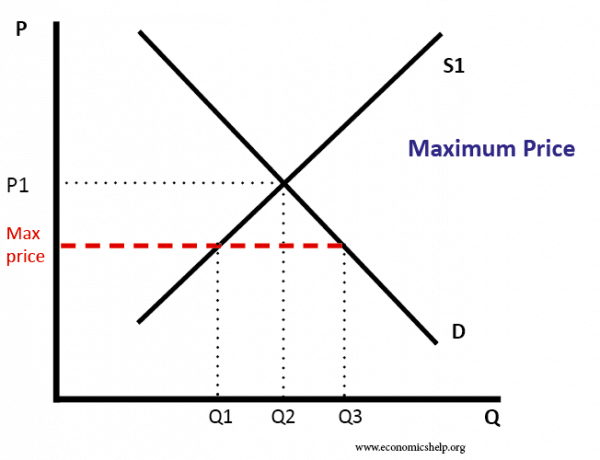Governments intervene in markets to try and overcome market failure. The government may also seek to improve the distribution of resources (greater equality). The aims of government intervention in markets include
- Stabilise prices
- Provide producers/farmers with a minimum income
- To avoid excessive prices for goods with important social welfare
- Discourage demerit goods/encourage merit good
Forms of government intervention in markets
- Minimum prices
- Maximum prices
- Minimum wages
- Nudges/Behavioural unit
Minimum Prices
This involves the government setting a lower limit for prices, e.g. the price of potatoes could not fall below 13p.
The minimum price could be set for a few reasons:
- Increase farmers incomes
- Increase wages
- Make demerit goods more expensive. For example, a minimum price for alcohol has been proposed.
Diagram Minimum Price
A minimum price will lead to a surplus (Q3 – Q1). Therefore the government will need to buy the surplus and store it. Alternatively, it may impose quotas on farmers to decrease the quantity of the good put onto the market.
Problems of minimum prices
- It could be costly for the government to buy the surplus
- A minimum price guarantee acts as an incentive for farmers to try and increase supply. As an unintended consequence, the minimum price encourages more supply than expected and the cost for the government rises. This happened with the EEC Common Agricultural Policy.
- To ensure minimum prices, the government may have to put tariffs on cheap imports – which damages the welfare of farmers in other countries.
Maximum Price
This involves putting a limit on any increase in price e.g. the price of housing rents cannot be higher than £300 per month.
Maximum prices may be appropriate in markets where
- Suppliers have monopoly power and are able to generate substantial economic rent by charging high prices
- The good is socially important – e.g. good quality housing is important to labour productivity and a nations’ health.
- Demand is price inelastic because the good is necessary for maintaining minimum standards of living.
Diagram Maximum Prices
The Maximum price will be set below the equilibrium. This makes sure the price is less than the market clearing price.
- However, the problem of a maximum price is that there will be a shortage. At Max Price, Demand is greater than supply. (Qe-Q1) This leads to queues and consumers unable to buy.
- This will encourage the operation of black markets.
- Therefore the government will have to ration the goods or increase supply
Evaluation
If supply and demand are very inelastic, then a maximum price may have little adverse impact on creating shortages. For example, if supply housing for rent is very profitable, then a maximum price will not stop landlords putting the house on the market.
Buffer Stocks
Agriculture suffers from various problems. These include:
- Fluctuating Prices
- Uncertainty leads to lack of income
- Low-Income elasticity of demand
- Positive Externalities of Farming
Therefore the government may feel there is a case to intervene and stabilise prices. A buffer stock involve a combination of minimum and maximum prices. The idea is to keep prices within a target price band.
Nudges
This is a different kind of government intervention. It is a government policy to influence demand indirectly. For example, putting cigarettes behind closed covers – makes it harder or less enticing for people to buy.
The government may also place flashing speed limit signs to give a smiley face to drivers under the speed limit, but an unhappy face to drivers exceeding the speed limit.
See: nudges
Tax
Tax is a method to discourage consumption of certain goods. For example, taxes on demerit goods – goods with negative externalities. Taxes both discourage consumption and raise revenue for the government.
In the above example, the tax moves output to Q2
Problems of tax
- Demand may be inelastic
- Hard for the government to know external cost and how much to tax
- May encourage tax evasion – e.g. rubbish tax can encourage fly-tipping
Subsidy
The government may subsidise goods with positive externalities (for example, public transport or education).
In the above example, a subsidy shifts output to 120 (where SMB = SMC) so it is more socially efficient.
Problems of subsidies
- Cost to government
- Subsidies may encourage firms to be inefficient because they can rely on government aid.
See also:





